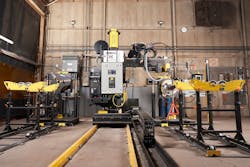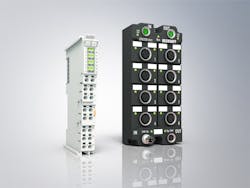Thanks to the rise of the Industrial Internet of Things (IIoT), the number and type of sensors deployed on factory floors is growing and in search of a streamlined way to communicate and share data, often in real-time.
Increasingly, that need is being met by IO-Link, considered the first global, standardized I/O (input/output) technology for communications with sensors and actuators. IO-Link (IEC 61131-9), has been popular in Europe for the last decade and been gaining ground in the United States thanks to its bi-directional, point-to-point communications approach that works through a standard three-wire connection. The IO-Link system market reached $11.2 billion in 2022 with expectations of a CAGR of 25.1% through 2028, according to a report from Mordor Intelligence.
Supported by a range of automation technology providers, including Siemens, Balluff, Banner Engineering, Beckhoff, Rockwell Automation and Festo, among others, IO-Link’s unified device-level communications method was designed to be easy to implement and include built-in diagnostics. Because of this, some users liken IO-Link to a USB for industrial applications.
IO-Link delivers a number of straightforward benefits, including simplified installation through standardized interfaces and three-wire cables, automated parameter settings for easy set up and device replacement and extended diagnostics, including at the field device level. The technology is also fieldbus independent, and its small form factor lends itself to the miniaturization of smart sensors and actuators—the backbone of data-centric applications such as predictive maintenance and advanced diagnostics.
“The availability of hugely valuable data from devices combined with vendor independence and interoperability makes IO-Link useful for implementing IIoT,” said Sean Foley, a product manager and business development manager in Banner Engineering’s wireless business unit.
However, IO-Link isn’t a fit for every scenario. It’s update speeds of up to 2.3 milliseconds don’t lend themselves to high-speed motion control applications and the 20 meter distance restriction between master and field devices can also be limiting, noted Foley.
Taking the time to consider specific application requirements and mapping out the network topology is the best way to maximize IO-Link usage. “You can use converters to mix and match IO-Link and non-IO-Link sensors in an application seamlessly,” Foley said. “It’s just important to have a plan.”
Following are insights on how three companies are leveraging IO-Link to their advantage.
Flexibility for OEMs
As LJ Welding Automation retools its welding equipment for a more integrated, less bolt-on design, flexibility and choice top its requirements list when considering a range of industrial automation technologies.
IO-Link has become the standard sensor communications backbone for an array of LJ Welding projects primarily because it keeps things simple, both from the standpoint of machine builder configuration and deployment as well as a way to cut back on inventory and streamline procurement, according to Dean Jacobs, principal automation engineer for LJ Welding.
The advantages offered by IO-Link has a number of advantages, according to Jacobs are: 1. It’s a standardized I/O (input/output) technology for communication with industrial sensors and actuators based on the established three-wire sensor and actuator connection, which is much easier and more cost-effective for engineers to work with compared to traditional shielded cabling; 2. It works with a variety of sensors and actuators, which means LJ Welding doesn’t have to keep a large selection of analog cards on hand, each calibrated to a different function and voltage setting.
“There’s typically a huge variety of analog input and output cards that, as a machine builder, I have to stock,” Jacobs said. “The big draw for IO-Link is that it can be input or output. I like the flexibility of buying one card and not having to stock six or seven. It simplifies procurement and gives me more design flexibility.”
IO-Link master terminals have a Data Storage Mode, which collects and stores process data such as measurement values from different devices, like temperature sensors. This aids in better diagnostics for the welding equipment, Jacobs said. “We get diagnostics we’d never get through a simple analog signal. We put sensors inside to get temperature readings and we can access the data through the diagnostic section of the IO-Link protocol. For troubleshooting, this capability is invaluable.”
LJ Welding is now using IO-Link master controllers from Beckhoff as a standard part of its build-out for a variety of its products, including the Pipe Titan pipe welding system it built and delivered to the Cleaver-Brooks facility in Stratford, Ontario. The IO-Link modules are part of a long list of Beckhoff automation equipment used in its various deployments, including PC-based control offerings and the TwinCAT3 automation software. On the Pipe Titan system, Beckhoff’s EL6224 IO-Link master terminal was used to connect a laser displacement sensor along with some additional applications. “The ability to bring the IO-Link devices into an EtherCAT network with a compact bus terminal adds greater flexibility to the system,” said Jacobs.
As noted earlier, IO-Link is not a fit for every application, but rather works best for “last mile” scenarios connecting sensors to a control system. Jacobs anticipates expanded use of IO-Link going forward as new sensors continue to be released with support for the communications technology. “[IO-Link] used to be a premium sensor option, but as more products come online, the cost premium is coming down and it’s opening the doors to more applications,” he said.
Oktoberfest gets an IIoT upgrade
Having plenty of beer and keeping it cool is a requisite for any brewery, but especially for the two-week-long Oktoberfest festival that has celebrated Bavarian culture for more than 200 years.
For years, the Paulaner Group’s Bräurosl tent, which can hold more than 8,000 people, made use of an underground ring-based piping system to supply the tent with beer. Yet the configuration was tied to the location and subject to weather conditions. It also lacked support for smart instrumentation that would provide real-time visibility into the beer poured every day.
Paulaner partnered with Endress+Hauser on a new piping system, installed directly in the tent, which provided location independence and made it simpler to set up the tent and take it down. More significantly, the new design incorporated Endress+Hauser instrumentation, including eight Picomag flowmeters incorporating an IO-Link interface. These additions deliver transparency into all temperature and conductivity measurement data in real-time, aiding in optimal planning and smooth operations, including when to clean the pipes and taps.
“The goal was for real-time Industrial Internet of Things (IIoT) visibility to see what type of beer is consumed, where in the tent it’s being consumed and the general volume of different beers for planning purposes so they don’t run out,” said Ola Wesstrom, U.S. industry manager for food and beverage responsibility at Endress+Hauser.
The addition of the IO-Link standard in the Picomag flowmeters was useful in several ways, Wesstrom said, particularly with regard to its standardized wiring and the data storage capabilities. “IO-Link ensures Paulaner can take the flowmeters, disassemble them and put them away for storage. And next year, when they’re plugged into the IO-Link Master, the configuration data is right there,” Wesstrom said. “This makes it easy to take apart and reassemble everything without a whole lot of special knowledge.”
IO-Link also ensures easy connectivity to the cloud, another benefit when collecting and analyzing the real-time data collected by the flowmeters and other sensors. “It’s an easy way to support both a traditional controls environment and the cloud for analysis, and IO-Link provides the avenue to do it,” he said.
Before committing to an IO-Link device, Wesstrom recommends industrial engineers fully understand the scope of their environment, including the layout of equipment and instruments such as sensors, detectors, masters and cables. He also advises engineers to keep IO-Link’s advantages and limitations in mind—for example, its data bandwidth can’t handle more than a few variables, and the standard only supports a guaranteed range of 20 meters.
“Make sure you understand your electrical and mechanical layout and the selection of all components before going down the IO-Link path, Wesstrom says.
Greater programmability for custom machine designs
Aerospec Inc., billed as a one-stop shop for custom automated machinery in the medical device, automotive, aerospace and defense and packaging industries, regularly turns to IO-Link to take complexity out of its designs.
This is possible because IO-Link eliminates wiring complexity, reduces costs and provide greater functionality, including a high degree of programmability not possible with traditional analog/digital sensors and actuators, according to Victor Rodriguez, software engineer for Aerospec.
For example, instead of designing a complex mechanical design to manually switch a sensor on and off or move a device for a recipe change, the team can accomplish the same objectives programmatically using IO-Link devices.
Rodriguez said Aerospec is currently using IO-Link on about half of its projects. “We try to introduce it wherever we can to be more cost effective.”
In an example use case offered by Rodriguez, the Aerospec team was tasked with a machine vision upgrade to an existing automotive manufacturing line, which required a camera to move to multiple positions to account for different airbag inflator product types. One option involved a complex mechanical set up that required an operator to physically move the camera to different locations as directed by sensors based on the specific recipe entered. Aerospec determined this approach was susceptible to human error and significant downtime when switching recipes, Rodriguez says.
Instead, the team decided to use Festo’s Simplified Motion Series line of actuators, which support IO-Link. The design choice enabled them to program the servo drive to move the camera to several positions based on the recipe entered by the operator without requiring any manual intervention. “Use of the IO-Link technology saved us a lot of integration labor and programming time,” Rodriguez says.
Going forward, Aerospec plans to leverage IO-Link capabilities for complex applications that benefit from more process and diagnostic data or when recipe parameter changes are involved. IO-Link can also help reduce downtime when there’s a need to swap sensors. “It’s a fairly newer piece of technology and it does have its limitations, but in most cases where you need extra data from sensors, IO-Link is a good fit,” Rodriguez said.




